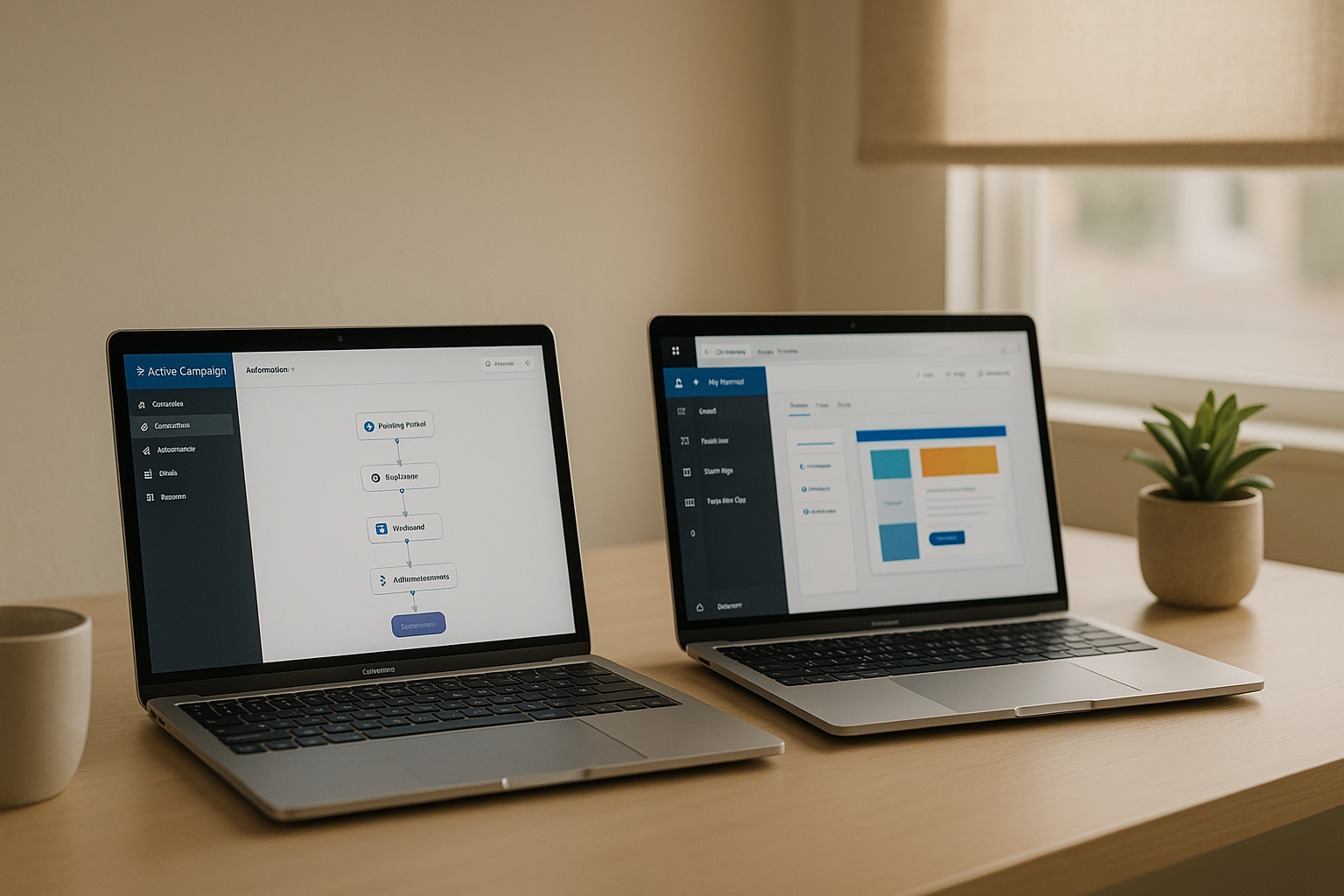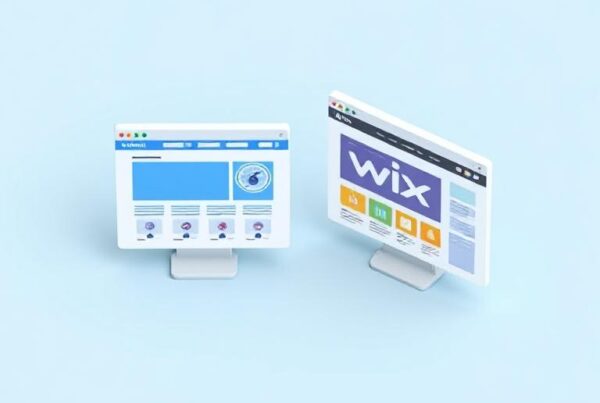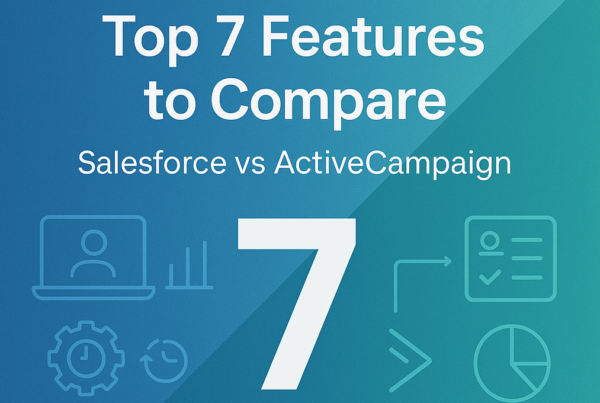When comparing ActiveCampaign vs ClickFunnels, you’re looking at two fundamentally different marketing tools with distinct specialties. ActiveCampaign is primarily an email marketing and automation powerhouse that offers a complete suite of tools for marketing and selling almost anything. ClickFunnels, however, mainly functions as a sales funnel builder designed to direct consumers toward specific actions, such as purchasing products or signing up for courses.
Understanding their core strengths is crucial if you’re looking for a clear comparison between ClickFunnels and ActiveCampaign for your small business. ActiveCampaign excels with its extensive email marketing capabilities and sophisticated automation features, including over 900 prebuilt automation recipes. Meanwhile, Clickfunnels’ email automation is a supporting feature rather than its primary focus. For businesses wondering what is better than Clickfunnels for comprehensive marketing automation, ActiveCampaign offers 30+ automation triggers and more than 40 actions to manage virtually any workflow you can imagine.
The pricing difference is also significant. ActiveCampaign’s Starter plan starts at just $15 per Month for 1,000 contacts, while ClickFunnels’ Basic plan begins at $97 per Month. Additionally, ActiveCampaign boasts over 870 integrations with other platforms and includes a built-in CRM system, making it a potentially more versatile choice for small businesses with diverse marketing needs.
Comparison Table: Activecampaign vs Clickfunnels
Here’s a quick comparison of ActiveCampaign and ClickFunnels’ features, pricing, and strengths to help you easily identify which platform aligns best with your business goals and marketing strategy.
| Feature | ActiveCampaign | ClickFunnels |
| Starting Price | $15/month | $97/month |
| Primary Focus | Email marketing & automation | Sales funnel building |
| Email Templates | 250+ | 37 |
| Form Types | Inline, Pop-up, Floating, Modal | Embedded in pages only |
| Automation Triggers | 30+ triggers, multiple per workflow | Limited, single trigger per workflow |
| Automation Templates | 900+ pre-built recipes | None |
| Landing Page Templates | 60+ templates | 80+ templates |
| Landing Page Focus | Email capture focused | Sales conversion-focused |
| Sales Funnel Building | Standalone pages only | Complete multi-step funnels |
| CRM Capabilities | Fully integrated CRM with pipeline management | Basic contact list with filtering |
| Lead Scoring | Dynamic, behavior-based | Basic, manual |
| A/B Testing Rating | 7.9 | 8.6 |
| Platform Integrations | 870+ | Not mentioned |
| Pricing Model | Contact-based scaling | Funnel-based scaling |
| AI Automation | Yes, with goal-based prompts | No, manual setup only |
Email Marketing Capabilities: Templates, Forms, and Campaign Types
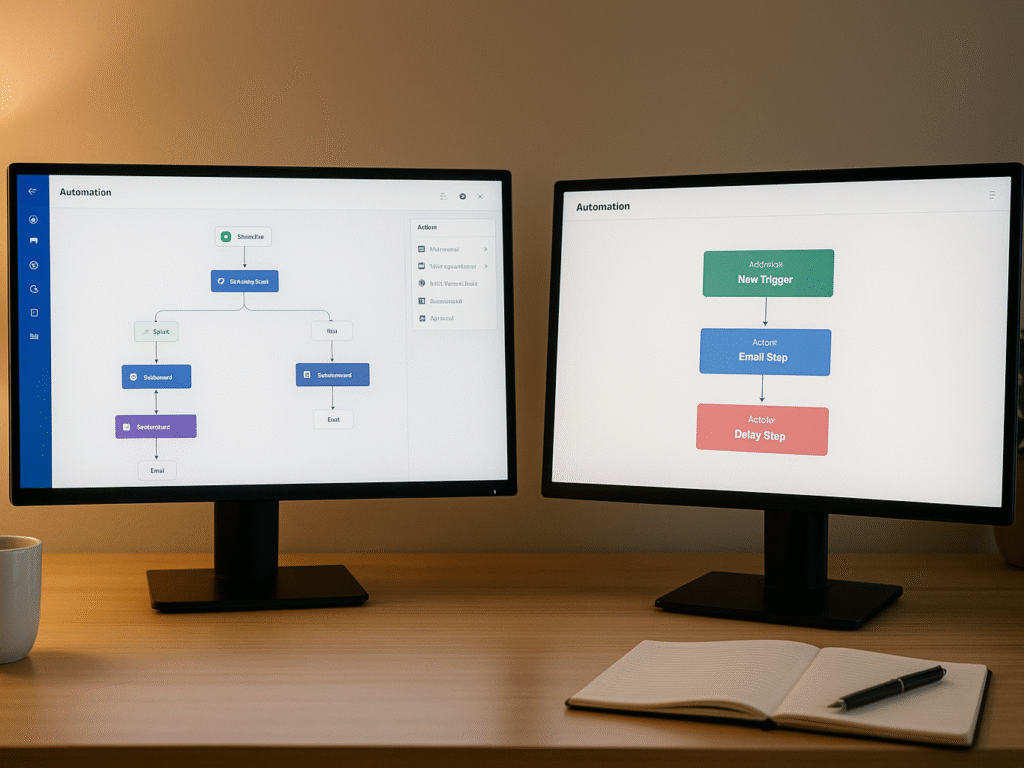
Email marketing is the core of any successful digital strategy, and the difference between ActiveCampaign and ClickFunnels in this arena is substantial. A closer examination of their capabilities reveals why many small businesses choose between these platforms primarily based on their email marketing needs.
1. Email Templates: 250+ vs 37 Options
The disparity in the template library between these platforms is striking. ActiveCampaign offers an impressive collection of over 250 email templates, giving you extensive options for every campaign type imaginable. These range from basic layouts to fully designed, colorful templates ready for immediate use.
Conversely, ClickFunnels offers just 37 email templates, many of which are basic text-only designs with noticeable repetition throughout the collection. This limitation becomes particularly significant for businesses that require varied email communications.
ActiveCampaign’s drag-and-drop editor makes customization straightforward. It allows you to preview templates across devices, including mobile, before sending. Furthermore, ActiveCampaign supports advanced personalization through message variables and conditional content that displays differently based on recipient characteristics.
2. Form Types: Inline, Pop-up, Floating vs Embedded in Pages Only
Form versatility represents another significant difference between these platforms: ActiveCampaign offers four distinct form types:
- Inline forms that blend seamlessly with your content and support unlimited fields
- Floating bar forms that remain visible at the top or bottom of your site
- Floating box forms that appear in corners for non-intrusive lead capture
- Modal forms that appear based on exit intent or other triggers
In contrast, ClickFunnels doesn’t provide standalone email capture forms. Instead, you must create entire landing pages with embedded forms, making it impossible to add simple signup forms to existing web pages.
3. Campaign Types: Broadcast, Autoresponder, RSS vs One-off Emails
ActiveCampaign’s email campaign capabilities are notably more robust. You can create and automate multiple campaign types:
- Standard broadcast emails
- Autoresponder sequences
- RSS-triggered emails that automatically send new content
- Split test campaigns for optimization
- Date-based emails for birthdays or anniversaries
Despite its email marketing capabilities, ClickFunnels only offers one-off broadcast emails as a standard feature. Although you can technically create autoresponders and sequences, these require manual setup through integrations and workflows rather than built-in functionalities.
For businesses heavily invested in email marketing, ActiveCampaign’s comprehensive toolset offers significantly more versatility and automation possibilities compared to ClickFunnels’ more basic email features.
Automation Features: Workflow Builders and Triggers Compared
Automation capabilities represent the starkest contrast in the Active Campaign vs. ClickFunnels debate. While both platforms offer workflow automation, the depth and flexibility of these features differ dramatically.
1. Trigger Options: 30+ vs Limited Single Trigger
ActiveCampaign’s automation engine offers exceptional flexibility, with over 30 trigger options to initiate workflows. This extensive selection allows you to create highly targeted automation based on virtually any customer action or data point. Moreover, ActiveCampaign enables you to combine multiple triggers for a single automation, such as “Contact subscribes to any list” paired with “Contact clicks a link in any email.”
Conversely, ClickFunnels offers a significantly more restricted automation system. It provides fewer trigger options, and each workflow can have only one trigger. This limitation forces you to create separate workflows for scenarios that could be handled in a single automation within ActiveCampaign.
2. Automation Templates: 900+ Recipes vs None
The most dramatic difference lies in prebuilt automation templates. ActiveCampaign offers an impressive library of over 900 automation recipes, covering virtually every marketing and sales function imaginable. These templates (called “recipes”) span multiple industries and languages, making them accessible to businesses of all types.
In stark contrast, ClickFunnels provides zero automation templates. Every workflow must be built entirely from scratch, regardless of how common the automation scenario might be. For small businesses with limited technical resources, this represents a substantial time investment compared to ActiveCampaign’s ready-to-use solutions.
3. AI Automation Builder: Goal-Based Prompts vs Manual Setup
ActiveCampaign has integrated AI throughout its platform, specifically in its automation builder. This intelligent system enables you to specify your business goal, and the AI will generate multiple custom automations tailored to your needs. For instance, you can describe this goal as attracting online learners and receiving several automation options tailored to this objective.
ClickFunnels lacks this AI-powered approach, requiring a manual setup for all workflows. Many users also report that ClickFunnels’ workflow builder isn’t intuitive. One reviewer noted frustration with the interface, describing how after adding a “Send Email” action, the system showed “No email set” despite the configuration being complete, requiring multiple clicks to resolve the issue.
Consequently, for businesses seeking powerful and flexible automation capabilities, the difference between these platforms is substantial — a key consideration in any ClickFunnels vs. ActiveCampaign comparison for marketing automation needs.
Landing Pages and Funnel Building Tools
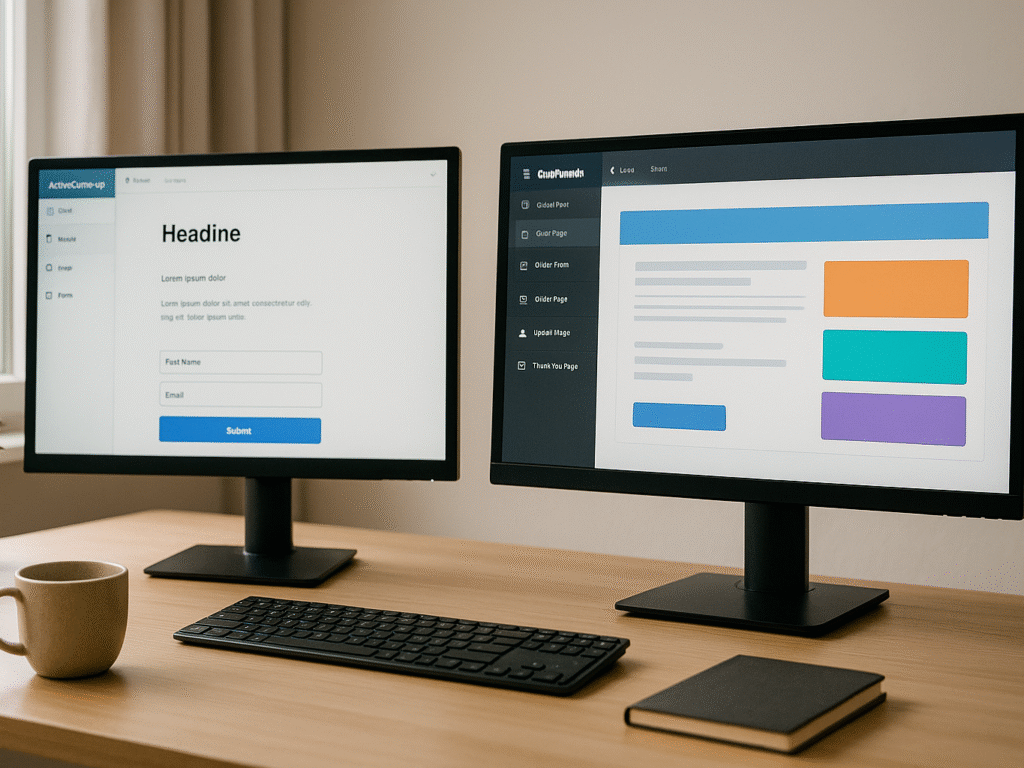
The battle between ActiveCampaign and ClickFunnels becomes most visible in their landing page and funnel-building capabilities, where their core design philosophies diverge.
1. Landing Page Customization: Advanced vs Basic
ClickFunnels delivers superior landing page customization with its sophisticated drag-and-drop editor. Its interface color-codes page elements when hovering, ensuring you know exactly what you’re working with. The platform offers over 80 landing page templates for sales, order confirmation, and upsell/cross-sell pages, providing extensive design flexibility.
ActiveCampaign, though competent, provides more limited landing page functionality. It offers 60+ landing page templates, primarily focused on email capture rather than sales conversion. The editor allows basic customization, including adjusting navigation, spacing, colors, and fonts. Still, it lacks the depth of design that ClickFunnels offers. ActiveCampaign offers landing pages on its Marketing Plus plan and higher tiers, making this feature considerably more expensive.
2. Sales Funnel Logic: Multi-Step Funnels vs Standalone Pages
Here lies the fundamental difference between these platforms. ClickFunnels excels with its prebuilt sales funnel templates designed to transform visitors into subscribers or customers. These multi-step funnels can:
- Collect email addresses
- Send thank-you emails
- Direct visitors to product pages
- Process payments
- Send order confirmations
- Offer one-click upsells or down-sells
In contrast, ActiveCampaign traditionally approaches lead generation. Its landing pages function as standalone entities that collect email addresses or process payments, but cannot be connected to create actual funnels. Simply put, ActiveCampaign doesn’t have a comparable sales funnel builder, as it isn’t focused on funnels.
3. A/B Testing: Full Funnel Testing vs Limited Email Testing
ClickFunnels offers comprehensive testing capabilities, earning an 8.6 rating for A/B testing, compared to ActiveCampaign’s 7.9. This platform enables you to split test virtually any element within your sales funnel, allowing you to optimize individual pages or entire customer journeys through conditional split paths.
ActiveCampaign offers solid A/B testing capabilities, with a primary focus on email campaigns rather than landing pages or funnels. This limitation reflects the platform’s email-centric approach, whereas ClickFunnels provides testing specific to sales funnel performance.
Ultimately, your choice depends on priority: ActiveCampaign excels in email marketing with basic landing page support. ClickFunnels shines when creating sales-focused conversion pathways with its specialized funnel-building tools.
Want to understand ClickFunnels’ true capabilities beyond the marketing hype? Our comprehensive review reveals what $160 million in revenue means for your business’s success.
[Read the full ClickFunnels truth here →]
CRM and Contact Management Tools
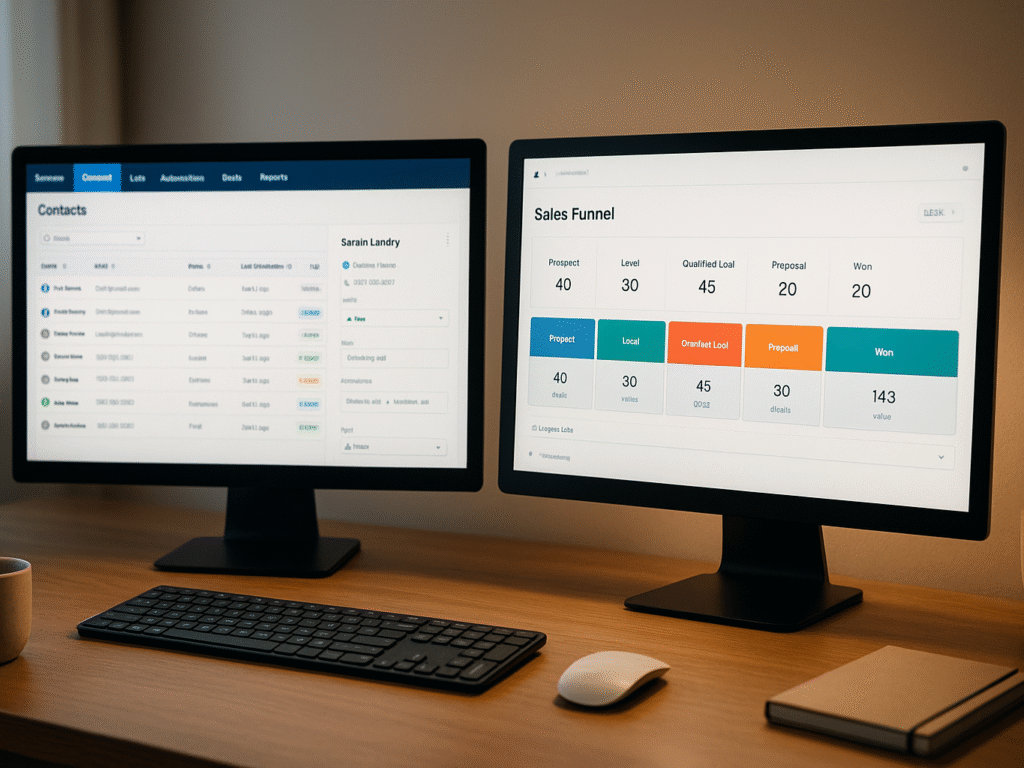
Customer relationship management capabilities fundamentally distinguish these two platforms when analyzing ActiveCampaign vs. ClickFunnels. Beyond marketing features, how each platform handles contact data and sales processes reveals its core business philosophies.
1. Built-in CRM: Full Pipeline vs Basic Contact List
ActiveCampaign delivers a fully integrated CRM system with comprehensive pipeline management capabilities. Under the ‘Deals’ tab, you can create custom sales pipelines and monitor each opportunity’s progress through various stages. Each contact receives a dedicated profile that displays contact details, ongoing deals, automation history, email interactions, and internal notes, making relationship management seamless, even with large contact databases.
In contrast, ClickFunnels offers a noticeably more limited contact management system, providing a basic contact list with filtering options. Its CRM features are challenging to locate, with contact management relegated to just two pages: a simple list view with basic attribute filters and a segments page for grouping contacts. You must add the separate Opportunities app for deal management, creating a disjointed experience compared to ActiveCampaign’s unified approach.
2. Lead Scoring and Segmentation: Dynamic vs Manual
ActiveCampaign excels with advanced lead scoring and segmentation capabilities that dynamically track and categorize leads based on their actions and engagement levels. This system can automatically score leads based on website visits, email engagement, and virtually any other field or interaction, highlighting your most promising prospects.
Conversely, ClickFunnels provides only basic lead-scoring functionality and typically relies on integrations for more sophisticated segmentation needs. While you can create segments to target campaigns, the platform lacks the dynamic, behavior-based segmentation that makes ActiveCampaign powerful for nurturing relationships.
3. Sales Engagement Workflows: Integrated vs Add-on Apps
The integration of sales and marketing represents yet another area where these platforms diverge significantly. ActiveCampaign’s sales engagement workflows create comprehensive journeys that span from initial lead capture to closing deals, all within a single, cohesive system. Its automation capabilities extend beyond marketing to organize deals in your CRM, collect contacts from platforms like Facebook, and segment audiences automatically.
Alternatively, ClickFunnels requires users to navigate different windows and tools to accomplish similar tasks. While ClickFunnels can automate certain aspects of deal management through its Quick Actions feature, the process feels disjointed compared to ActiveCampaign’s seamless approach. For businesses seeking deep CRM functionality integrated with marketing automation, ActiveCampaign presents a substantially more unified solution than what Clickfunnels’ email automation can provide.
Pricing and Value for Small Businesses
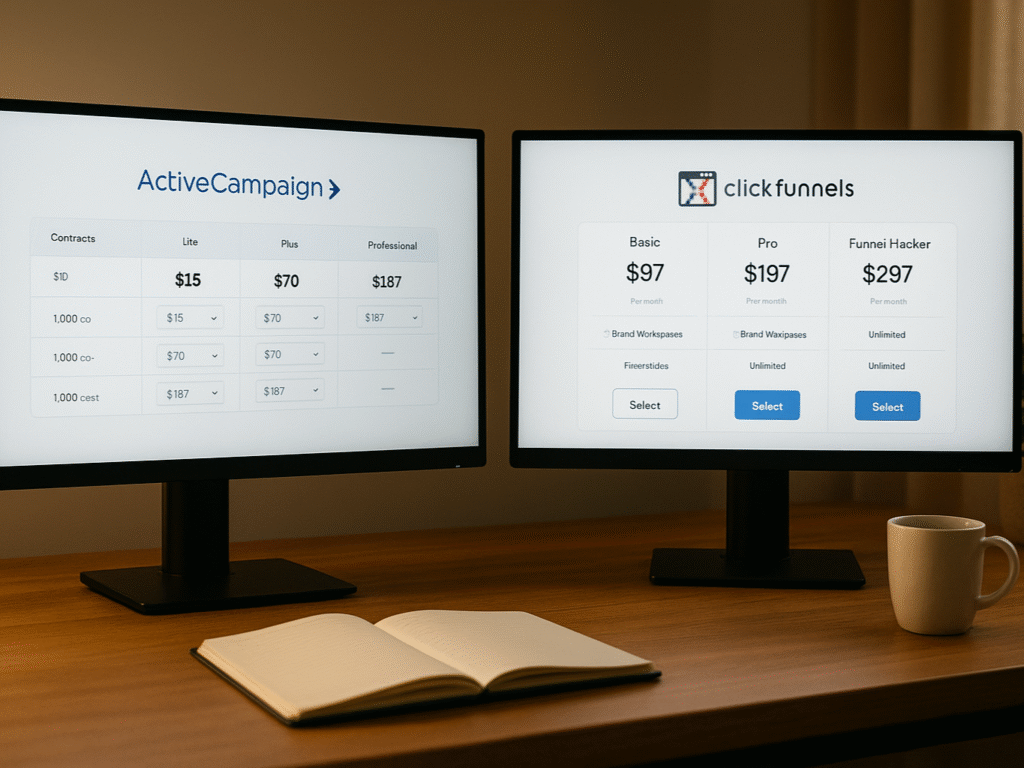
The pricing structure often becomes the deciding factor for small businesses comparing ActiveCampaign and ClickFunnels. Understanding the cost implications reveals fundamental differences in how each platform approaches value delivery.
1. Entry-Level Pricing: $15 vs $97 per Month
The starting price gap between these platforms is substantial. ActiveCampaign’s Starter plan, which supports up to 1,000 contacts, starts at just $15 per Month, providing an accessible entry point for budget-conscious startups. In stark contrast, ClickFunnels’ basic plan starts at $97 monthly, requiring a significantly higher initial investment.
This price difference becomes even more pronounced when examining what each entry-level plan includes. ActiveCampaign’s Starter plan offers multi-step marketing automation, a single-user account, and email marketing capabilities. ClickFunnels’s starting package includes three brand workspaces, three team members, and unlimited funnels.
2. Feature Access by Tier: Limited vs All-in-One
Each platform distributes features differently across pricing tiers. ActiveCampaign follows a tiered feature approach, where capabilities like landing pages and SMS marketing become available only in higher-priced plans. Its Starter plan noticeably excludes essential features such as landing pages, advanced reporting, and split automation.
Alternatively, ClickFunnels embraces an all-in-one pricing philosophy. Even at its entry-level tier, you can access its entire marketing and sales tools suite, including unlimited contacts. This approach means you’re not constantly discovering feature limitations as your marketing needs evolve.
3. Scalability: Contact-Based vs Funnel-Based Plans
The scalability models differ substantially between platforms. ActiveCampaign’s pricing scales based on contact volume, with costs increasing as your subscriber list grows. For instance, the Pro plan jumps from $79 per Month for 1,000 contacts to significantly higher prices for larger lists.
Conversely, ClickFunnels scales based on workspace and funnel capacity. Its pricing tiers primarily differentiate by the number of brand workspaces (3 vs. 10), team members (3 vs. 10), and funnel limitations. Accordingly, this makes ClickFunnels more cost-effective for businesses with large contact lists but straightforward funnel needs.
Ultimately, small businesses must weigh immediate budget constraints against long-term scaling considerations when deciding between ClickFunnels and ActiveCampaigns.
Concerned about ActiveCampaign’s pricing structure as your contact list grows? Our detailed 2025 review breaks down the real costs and reveals budget-friendly alternatives that deliver similar results.
[Discover ActiveCampaign alternatives here →]“
Conclusion: Making Your Final Decision
Choosing between ActiveCampaign and ClickFunnels depends on your small business’s needs. ActiveCampaign excels in email marketing, CRM, and automation, offering 900+ automation recipes and flexible templates at a lower cost. ClickFunnels specializes in creating optimized sales funnels with advanced landing pages and A/B testing, though at a higher price.
Your marketing strategy matters. Choose ActiveCampaign if email marketing and detailed customer management are key to your business. Opt for ClickFunnels if your model relies on multi-step sales funnels with upsells and cross-sells. Both platforms offer free trials, allowing you to evaluate which suits your approach and growth stage.
Ultimately, the best choice isn’t about having more features but finding the right fit for your goals. Many small businesses start with ActiveCampaign for its affordability and automation, then shift to ClickFunnels as funnel complexity increases. Test both tools and invest where your marketing efforts will yield the most benefit.
FAQs on ActiveCampaign vs. ClickFunnels
Q1. What is the primary focus of ActiveCampaign?
ActiveCampaign focuses on email marketing, automation, and CRM tools. It helps businesses create targeted campaigns, segment audiences, and build automated workflows to nurture leads, boost engagement, and drive sales across various channels.
Q2. How does ClickFunnels differ from ActiveCampaign?
ClickFunnels is primarily a sales funnel builder. It’s designed to guide users through multi-step funnels toward specific actions, such as purchasing products, booking appointments, or enrolling in courses, with a strong emphasis on landing pages and conversion optimization.
Q3. What are the pricing differences between ActiveCampaign and ClickFunnels?
ActiveCampaign starts at $15 per Month for 1,000 contacts, making it an affordable option for smaller businesses. ClickFunnels’ Basic plan begins at $97 per Month, reflecting its more specialized focus on sales funnels and landing page creation.
Q4. Which platform offers more email templates?
ActiveCampaign offers users over 250 customizable email templates to meet various marketing needs. In comparison, ClickFunnels includes only 37 email templates, as its primary strength lies in building sales funnels and conversion-driven landing pages.


